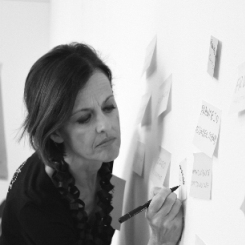Tangible and Embodied Interaction
A special issue of Informatics (ISSN 2227-9709).
Deadline for manuscript submissions: closed (16 July 2017) | Viewed by 47104
Special Issue Editors
Interests: tangible and embodied interaction; IoT; sensemaking; aesthetics; ethics; transformative qualities; multi-stakeholder design; design for health and wellbeing
2. Industrial Design Department, Eindhoven University of Technology, 5612 AZ Eindhoven, The Netherlands
Interests: experience design; interaction design; tangible interaction; human-robot interaction; educational technologies; inclusive design
Special Issues, Collections and Topics in MDPI journals
Special Issue Information
Dear Colleagues,
This Special Issue of Informatics welcomes submissions on the topic of tangible and embodied interaction (TEI). Computers are, nowadays, woven into the fabric of our everyday social life, including our physical environment, making “the computer” go way beyond the traditional desktop machine supporting us to perform our work; it helps us to pursue our lives. Physical appliances have gained computational behaviours, which has opened up the field of tangible and embodied interaction (TEI). Tangible interaction aims at direct engagement with our digital world through physical artefacts (Ishii et al., 2012). Paul Dourish extended this concept towards Embodied Interaction, which includes the physical as well as the social world (2001). The apparent lines between the physical and digital, the material and immaterial, the personal and social seem to be blurring slowly but certainly. New developments like the Internet of things, shape changing interfaces and augmented reality are boosting the value and development of the field of TEI.
Over the last few decades, TEI has moved from a more conceptual level, like Durrell Bishop’s Marble Answering Machine (1992) towards experienceable, publicly and even commercially available designs like Reactable and the newly related Rotor (Jordà., 2008). However, there is still extensive terrain for TEI to conquer to be completely interwoven into our everyday life. It will require a close cooperation between different fields including informatics, hardware and sensor technology, human computer interaction, interaction and product design, computer-supported cooperative work, social and cultural computing, social sciences, humanities and art amongst others.
We encourage authors to submit their original research articles, work in progress, surveys, reviews, and viewpoint articles in the TEI field. This Special Issue welcomes applications, theories, models, and frameworks—whether conceptual, analytical, prescriptive, predictive, design-related, or otherwise—that are concerned with (but not limited to) the following topics as they relate to TEI:
- Aesthetics
- Business and industrial applications
- Case studies
- Choreography of interaction
- Cultural practices
- Embodiment
- Internet of things
- Physical / digital hybrids
- Somaesthetic design
- Design guidelines, methods, and processes
- Embodied Cognition
- Ethics
- Future visions
- Human perception
- Information Behaviour
- Innovative systems
- Interaction designs
- Interactive Spaces
- Key challenges
- Novel interactive use
- Philosophical & social implications
- Production products and tools
- Sensemaking
- Sensors and actuators
- Shape changing interfaces
- Social practices
- Standardization
- Tangible tools
- TEI paradigms
- Theoretical foundations, frameworks, and concepts
- Toolkits and software architectures
Prof. Dr. Caroline Hummels
Prof. Dr. Patrizia Marti
Guest Editors
Manuscript Submission Information
Manuscripts should be submitted online at www.mdpi.com by registering and logging in to this website. Once you are registered, click here to go to the submission form. Manuscripts can be submitted until the deadline. All submissions that pass pre-check are peer-reviewed. Accepted papers will be published continuously in the journal (as soon as accepted) and will be listed together on the special issue website. Research articles, review articles as well as short communications are invited. For planned papers, a title and short abstract (about 100 words) can be sent to the Editorial Office for announcement on this website.
Submitted manuscripts should not have been published previously, nor be under consideration for publication elsewhere (except conference proceedings papers). All manuscripts are thoroughly refereed through a single-blind peer-review process. A guide for authors and other relevant information for submission of manuscripts is available on the Instructions for Authors page. Informatics is an international peer-reviewed open access quarterly journal published by MDPI.
Please visit the Instructions for Authors page before submitting a manuscript. The Article Processing Charge (APC) for publication in this open access journal is 1800 CHF (Swiss Francs). Submitted papers should be well formatted and use good English. Authors may use MDPI's English editing service prior to publication or during author revisions.
References
Hiroshi Ishii, Dávid Lakatos, Leonardo Bonanni, and Jean-Baptiste Labrune (2012). Radical atoms: beyond tangible bits, toward transformable materials. Interactions 19, 1, January 2012, 38-51.
Dourish P., (2001). Where the action is: The foundations of embodied interaction. Cambridge, Mass.: MIT Press.
Jordà, S. (2008). On Stage: the Reactable and other Musical Tangibles go Real. International Journal of Arts and Technology, 1-3/4: 268-287.






